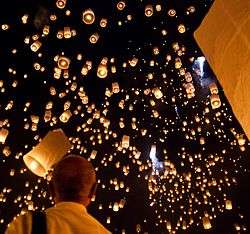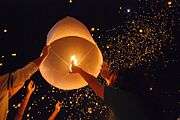Sky lantern



A sky lantern (simplified Chinese: 天灯; traditional Chinese: 天燈; pinyin: tiāndēng), also known as Kongming lantern or Chinese lantern, is a small hot air balloon made of paper, with an opening at the bottom where a small fire is suspended.
In Asia and elsewhere around the world, sky lanterns have been traditionally made for centuries, to be launched for play or as part of long-established festivities. The name sky lantern is a translation of the Chinese name but they have also been referred to as sky candles or fire balloons.
Construction
The general design is a thin paper shell, which may be from about 30 cm to a couple of metres across, with an opening at the bottom. The opening is usually about 10 to 30 cm wide (even for the largest shells), and is surrounded by a stiff collar that serves to suspend the flame source and to keep it away from the walls.
When lit, the flame heats the air inside the lantern, thus lowering its density and causing the lantern to rise into the air. The sky lantern is only airborne for as long as the flame stays alight, after which the lantern sinks back to the ground.
- In China and Taiwan, sky lanterns are traditionally made from oiled rice paper on a bamboo frame. The source of hot air may be a small candle or fuel cell composed of a waxy flammable material.
- In Thailand, sky lanterns are often traditionally made from oiled rice paper on a bamboo frame. They may also be constructed from other lightweight papers. The source of hot air is usually a small candle or fuel cell composed of a waxy flammable material lit and which usually stays lit despite the surrounding air currents. The Thai name is khom loi. Many areas of Asia, however, do not permit sky lanterns because of widespread fire hazards as well as danger to livestock.
- In Brazil, Mexico, and possibly other Latin American countries, sky lanterns were traditionally made of several patches of thin translucent paper (locally called "silk paper"), in various bright colors, glued together to make a multicolored polyhedral shell. A design that was fairly common was two pyramids joined by the base (a bipyramid, such as the octahedron) sometimes with a cube or prism inserted in the middle. Only the smaller models had a full frame made of bamboo or thin wire; the slight overpressure of the hot air was sufficient to keep the larger ones inflated, and the frame was reduced to a wire loop around the bottom opening. The "candle" was usually a packet of paraffin or rosin tightly wrapped in cloth and bound with wire.
History
According to the sinologist and historian of science Joseph Needham, the Chinese experimented with small hot air balloons for signaling from as early as the 3rd century BCE, during the Warring States period. Traditionally, however, their invention is attributed to the sage and military strategist Zhuge Liang (181–234 CE),[1] whose reverent term of address was Kongming. He is said to have used a message written on a sky lantern to summon help on an occasion when he was surrounded by enemy troops. For this reason, they are still known in China as Kongming lanterns (孔明燈, 孔明灯, kǒngmíng dēng). Another suggested origin is that the name actually comes from the lantern's resemblance to the hat Kongming is traditionally shown to be wearing.
Sky lanterns could be a possible explanation for some UFO sightings through the years.[2][3]
Usage in festivals
China
In ancient China, sky lanterns were strategically used in wars. However, later on, non-military applications were employed as they became popular with children at festivals. These lanterns were subsequently incorporated into festivals like the Chinese Mid-Autumn and Lantern Festivals.
India
To represent the Star of Bethlehem during Christmas season, as part of celebrations sky lanterns are released into the night sky with hopes towards a new year. In Bengal and Northeast India, Buddhist people celebrate their Probarona Purnima which signifies end of their three-month lent by releasing lighted sky lanterns (fanush), it is the second largest festival of the Buddhist community. During Diwali festival (The festival of Light) eco-friendly sky lanterns are used for celebrations along with fireworks.
Portugal and Brazil
In Brazil, sky lanterns (balão in Portuguese) were a traditional feature of the winter holidays (Festas Juninas) at the end of June. It is claimed that custom was brought to Brazil from Portugal by colonists in the 16th century, and is still strong in Portugal, especially in Porto. The June holidays tradition also includes firecrackers and fireworks, another Chinese invention; so it is conjectured that these elements may have been brought from China by Portuguese explorers around 1500. The design and customs of Brazilian sky lanterns are modified to suit their festivals.
Frei Bartolomeu de Gusmão, using a large scale version of these lanterns, was the first man to fly a hot air balloon in 8 August 1709, in the hall of the Casa da Índia in Lisbon, Portugal, long before the Montgolfier brothers.
Brazilian sky lanterns are usually made by small groups of children and adolescents; but adults sometimes joined the effort, especially for the larger and more elaborate balloons. The launching of a large lantern, which could be one or two metres across, would usually require the cooperation of several people, to hold the balloon fully stretched until it was fully inflated. Lanterns with 20 meters or more and loaded with firecrackers and large flags are not uncommon. It is important to note that launching lanterns in Brazil is an environmental crime, punishable by up to 3 years in jail since 1998.[4]
Taiwan
Pingxi District in New Taipei City of Taiwan holds an annual Lantern Festival in which sky lanterns are released into the night sky with people's wishes written, to send the wishes and messages to God. Lantern Festival is also as known as the 15th days of Lunar New Year, the last day of celebration for Lunar New Year.
Thailand

The Lanna people of northern Thailand use "floating lanterns" (โคมลอย, khom loi) year round, for celebrations and other special occasions. One very important festival in which sky lanterns are used is the Yi Peng festival, which is held on a full moon of the 2nd month (ยี่เป็ง, Yi Peng) of the Lanna calendar (which coincides with Loi Krathong, the traditional festival on the 12th month of the Thai lunar calendar). During the Yi Peng festival, a multitude of lanterns are launched into the air where they resemble large flocks of giant fluorescent jellyfish gracefully floating by through the sky. The most elaborate Yi Peng celebrations can be seen in Chiang Mai,[5] the ancient capital of the former Lanna kingdom. The festival is meant as a time to obtain Buddhist merit (ทำบุญ, tham bun). In recent times, floating lanterns have become so popular with all Thai people that they have become integrated into the festival in the rest of the country.
In addition, people will also decorate their houses, gardens and temples with intricately shaped paper lanterns (โคมไฟ, khom fai) of various forms. It is considered good :} luck to release a sky lantern, and many Thais believe they are symbolic of problems and worries floating away.
Dangers

A sky lantern may land when the flame is still alight, making it a fire hazard.[6] In typical designs, as long as the lantern stays upright the paper will not get hot enough to ignite, but if the balloon is tilted (say, by the wind or by hitting some object), it may catch fire while still in the air. All the paper will usually burn in a few seconds, but the flame source may remain lit until it hits the ground.
After the balloon lands, the leftover thin wire frame will rust away very slowly, remaining a hazard to animals that may swallow it.[7] In 2009 British company Sky Orbs Chinese Lanterns developed lanterns with a bio-degradable fireproof rope in place of metal wire.[8] Many other European manufacturers adopted similar designs. In 2012 the same company released a patented design with fireproof base following reports of fires caused by lanterns.[9]
Sky lanterns have also been alleged to pose a danger to aircraft.[10]
On 1 July 2013 the 'largest fire ever' in the West Midlands of England, involving 100,000 tonnes of recycling material and causing an estimated six million pounds worth of damage, was started by a sky lantern which landed at a plastics recycling plant in Smethwick. Images of the lantern starting the fire were captured on CCTV.[11][12] In response to the fire, Poundland decided to stop selling sky lanterns and recalled their entire stock on 6 July 2013.[13]
In 2018 a pavilion at Riocentro Convention Center, near downtown Rio de Janeiro, Brazil, fully burned after a sky balloon landed on its roof.[14]
Legal status
Despite their use for centuries, there has been growing concern by some about the potential danger to cause crop or building fires and even harm animals that may eat their remains. Despite the general lack of prevalence some places have banned them for these reasons.[15]
The city of Sanya in China banned sky lanterns due to their hazards toward aircraft and airspace navigation.[16]
It is illegal to launch a sky lantern in most parts of Germany; where use is not illegal, as in Herford, it is necessary to obtain advance permission from local authorities. In Austria, it is illegal to produce, sell, import, or distribute them.[17] In Argentina, Chile, and Colombia it is illegal to launch lanterns, as well as in Spain and Vietnam. In Brazil launching lanterns is an environmental crime, punishable by up to 3 years in jail since 1998.[10]
Retail sale (but not possession and use) of sky lanterns that "rely on an open flame to heat the air inside the lantern" was banned in Australia on 1 February 2011.[18]
Sky Lanterns have also been banned in Kittitas County, Washington due to fire concerns on 20 June 2013.[19] Since then, Washington state has banned sky lanterns statewide.
See also
References
- ↑ Yinke Deng (2005). 中国古代发明 (Ancient Chinese Inventions). 五洲传播出版社. ISBN 7508508378.
- ↑ Speigel, Lee (2011-04-04). "Chicago UFO Mystery Solved: They Were Sky Lanterns in Honor of Child Abuse Victims". AOL News. Archived from the original on 2013-01-20. Retrieved 2013-02-24.
- ↑ Scribbens, Nicola (2009-06-11). "Readers say Burnham-On-Sea UFO was probably a Chinese lantern". Burnham-On-Sea.com. Retrieved 2013-02-02.
- ↑ "Fabricar, vender ou soltar balões que possam provocar incêndio é crime — Especial Cidadania - Jornal do Senado". www12.senado.leg.br (in Portuguese). Retrieved 2018-01-03.
- ↑ "Lantern Festival of the Yee Peng Month". Welcome to Chiangmai and Chiangrai magazine. 2012-12-03. Archived from the original on 2013-02-28. Retrieved 2013-02-24.
- ↑ Gancia, Barbara (2004-08-06). "Inconseqüência sazonal vitima mais um" (in Portuguese). Folha de São Paulo (online). Retrieved 2013-02-02.
Firefighters have been striving for five days to put out a criminal fire in the Guarulhos region. This time it was a tire recycling company; but it could have happened to my home, or to yours, dear reader.
- ↑ Hickman, Leo (2009-07-31). "What's the environmental impact of a sky lantern?". The Guardian. Retrieved 2013-02-24.
- ↑ "Sky's The Limit For Eco Friendly Chinese Lanterns". Manchester Evening News. 2011-06-15. Retrieved 2013-02-24.
- ↑ "Sky Orbs wins £100k Russian order". Manchester Evening News. 2012-09-28. Retrieved 2013-02-24.
- 1 2 "Balão cai no aeroporto de Cumbica; Infraero faz campanha de prevenção" (in Portuguese). Folha de São Paulo (online). 2008-05-14. Retrieved 2013-02-24.
Only last year the state-owned company recorded at the Guarulhos [=Cumbica] airport 104 incident. In 2008 [...] there were already 17 incidents.
- ↑ http://www.itv.com/news/story/2013-07-01/major-blaze-at-recycling-plant-smethwick-west-midlands
- ↑ https://www.bbc.co.uk/news/uk-england-birmingham-23123549
- ↑ "Poundland Stops Selling Chinese Lanterns After Massive Fire In Smethwick". Huffington Post. 2013-07-06. Retrieved 2013-07-06.
- ↑ https://www.theguardian.com/world/2018/aug/01/fields-medal-award-stolen-brazil-maths-prize
- ↑ "Chinese lanterns pose danger to livestock, NFU says". BBC News. 2010-02-01. Retrieved 2010-09-08.
- ↑ Romana, Chito (2009-03-27). "Why Did China Ban Traditional Flying Lanterns? - World View". Blogs.abcnews.com. ABC News. Archived from the original on 2009-03-30. Retrieved 2013-02-24.
- ↑ "BUNDESGESETZBLATT FÜR DIE REPUBLIK ÖSTERREICH" (PDF) (in German). 2009-12-09. Retrieved 2013-02-24.
- ↑ "Sky lanterns". Australian Competition and Consumer Commission. 2012. Archived from the original on 2012-01-01. Retrieved 2012-01-01.
- ↑ "Fire danger prompts ban of sky lanterns". 2013-06-20. Retrieved 2013-07-12.
External links
| Wikimedia Commons has media related to Sky lanterns. |
- How to Make Chinese Sky Lanterns
- Chen, Melody (21 February 2005). "Pingsi Festival Sends Lanterns Toward Heaven". Taipei Times. p. 2. Retrieved 3 September 2018.